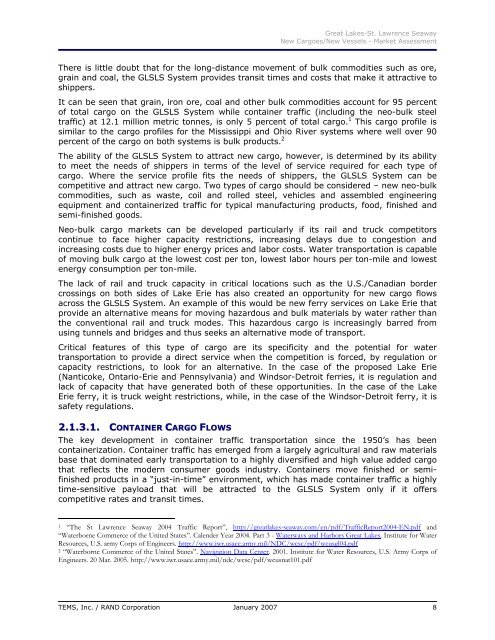great lakes-st. lawrence seaway new cargoes/new vessels market
great lakes-st. lawrence seaway new cargoes/new vessels market
great lakes-st. lawrence seaway new cargoes/new vessels market
- No tags were found...
Create successful ePaper yourself
Turn your PDF publications into a flip-book with our unique Google optimized e-Paper software.
Great Lakes-St. Lawrence SeawayNew Cargoes/New Vessels - Market AssessmentThere is little doubt that for the long-di<strong>st</strong>ance movement of bulk commodities such as ore,grain and coal, the GLSLS Sy<strong>st</strong>em provides transit times and co<strong>st</strong>s that make it attractive toshippers.It can be seen that grain, iron ore, coal and other bulk commodities account for 95 percentof total cargo on the GLSLS Sy<strong>st</strong>em while container traffic (including the neo-bulk <strong>st</strong>eeltraffic) at 12.1 million metric tonnes, is only 5 percent of total cargo. 1 This cargo profile issimilar to the cargo profiles for the Mississippi and Ohio River sy<strong>st</strong>ems where well over 90percent of the cargo on both sy<strong>st</strong>ems is bulk products. 2The ability of the GLSLS Sy<strong>st</strong>em to attract <strong>new</strong> cargo, however, is determined by its abilityto meet the needs of shippers in terms of the level of service required for each type ofcargo. Where the service profile fits the needs of shippers, the GLSLS Sy<strong>st</strong>em can becompetitive and attract <strong>new</strong> cargo. Two types of cargo should be considered – <strong>new</strong> neo-bulkcommodities, such as wa<strong>st</strong>e, coil and rolled <strong>st</strong>eel, vehicles and assembled engineeringequipment and containerized traffic for typical manufacturing products, food, finished andsemi-finished goods.Neo-bulk cargo <strong>market</strong>s can be developed particularly if its rail and truck competitorscontinue to face higher capacity re<strong>st</strong>rictions, increasing delays due to conge<strong>st</strong>ion andincreasing co<strong>st</strong>s due to higher energy prices and labor co<strong>st</strong>s. Water transportation is capableof moving bulk cargo at the lowe<strong>st</strong> co<strong>st</strong> per ton, lowe<strong>st</strong> labor hours per ton-mile and lowe<strong>st</strong>energy consumption per ton-mile.The lack of rail and truck capacity in critical locations such as the U.S./Canadian bordercrossings on both sides of Lake Erie has also created an opportunity for <strong>new</strong> cargo flowsacross the GLSLS Sy<strong>st</strong>em. An example of this would be <strong>new</strong> ferry services on Lake Erie thatprovide an alternative means for moving hazardous and bulk materials by water rather thanthe conventional rail and truck modes. This hazardous cargo is increasingly barred fromusing tunnels and bridges and thus seeks an alternative mode of transport.Critical features of this type of cargo are its specificity and the potential for watertransportation to provide a direct service when the competition is forced, by regulation orcapacity re<strong>st</strong>rictions, to look for an alternative. In the case of the proposed Lake Erie(Nanticoke, Ontario-Erie and Pennsylvania) and Windsor-Detroit ferries, it is regulation andlack of capacity that have generated both of these opportunities. In the case of the LakeErie ferry, it is truck weight re<strong>st</strong>rictions, while, in the case of the Windsor-Detroit ferry, it issafety regulations.2.1.3.1. CONTAINER CARGO FLOWSThe key development in container traffic transportation since the 1950’s has beencontainerization. Container traffic has emerged from a largely agricultural and raw materialsbase that dominated early transportation to a highly diversified and high value added cargothat reflects the modern consumer goods indu<strong>st</strong>ry. Containers move finished or semifinishedproducts in a “ju<strong>st</strong>-in-time” environment, which has made container traffic a highlytime-sensitive payload that will be attracted to the GLSLS Sy<strong>st</strong>em only if it offerscompetitive rates and transit times.1 “The St Lawrence Seaway 2004 Traffic Report”, http://<<strong>st</strong>rong>great</<strong>st</strong>rong><<strong>st</strong>rong>lakes</<strong>st</strong>rong>-<strong>seaway</strong>.com/en/pdf/TrafficReport2004-EN.pdf and“Waterborne Commerce of the United States”. Calender Year 2004. Part 3 - Waterways and Harbors Great Lakes. In<strong>st</strong>itute for WaterResources, U.S. army Corps of Engineers. http://www.iwr.usace.army.mil/NDC/wcsc/pdf/wcusgl04.pdf2 “Waterborne Commerce of the United States”. Navigation Data Center. 2001. In<strong>st</strong>itute for Water Resources, U.S. Army Corps ofEngineers. 20 Mar. 2005. http://www.iwr.usace.army.mil/ndc/wcsc/pdf/wcusnat101.pdfTEMS, Inc. / RAND Corporation January 2007 8
















